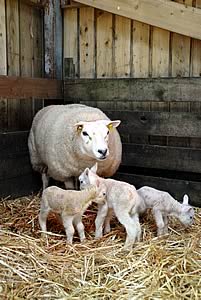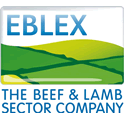 |
|||||||||
|
|||||||||||||||||||
|
|
Blood Test to Fine-Tune Late Pregnancy Feeding Blood testing a small sample of ewes a month ahead of lambing could be particularly useful in avoiding lambing problems and securing the best possible lamb growth rates this season, suggests EBLEX, the industry body for beef and lamb levy-payers in England.
With 70% of foetal growth and the bulk of udder development occurring in the final six weeks of pregnancy, ensuring the right nutrition in the run-up to lambing is one of the most important essentials of flock management; especially so where ewes are under the additional stress of persistently cold winter weather. Under these conditions failure to fine-tune late pregnancy energy and protein intakes sufficiently to actual ewe needs can easily compromise lamb vigour and survival, ewe health and colostrum production and, as a result, seriously undermine flock performance. Vital as body condition monitoring continues to be for nutritional management, it can be too insensitive to pick-up inadequacies in ewe energy and protein levels ahead of lambing in many cases. This makes a simple, vet-organised blood test to indicate the actual nutritional state of the ewes invaluable. EBLEX recommends testing a group of 10-12 ewes representing a good cross-section of breed types, diets (if sufficiently different), litter size (established through scanning) and body condition scores. Testing should be conducted three to four weeks before lambing and, ideally, four hours after the last supplementary feed. Key parameters to measure are beta-hydroxybutyrate (BOHB), urea and serum albumin. BOHB is a ketone produced when ewes mobilise body reserves in the absence of sufficient dietary energy. Some body fat mobilisation is inevitable in late pregnancy, but the Moredun Institute regards BOHB levels of 1.1 mmol/litre or higher in the blood as a sign that additional feed energy may be necessary to guard against twin lamb disease (ketosis). As a by-product of dietary protein breakdown in the liver, blood urea levels are an indicator of short-term protein sufficiency. Levels of less than 2-3 mmol/litre suggest the diet could profit from additional protein. They can, however, be very variable and are heavily influenced by the timing of the last feed. So they should be considered alongside the long-term protein supply indicator, serum albumin; levels of 26-30 g/litre being normal in late pregnancy. Veterinary advice should always be sought in interpreting the blood test results and making any changes to either diets or groups, EBLEX cautions, with useful extra ewe feeding information available free of charge to English levy payers in Sheep BRP Manual 12: Improving Ewe Nutrition for Better Returns from 0870 2418829 or brp@eblex.org.uk.
|
||||||||||||||||||

|
|
||||||||||||||||||
| home | agri-services | pedigree
pen | news | dairy | beef | machinery property | organisations | site map |
|||||||||||||||||||

